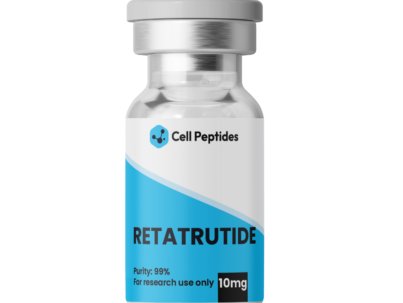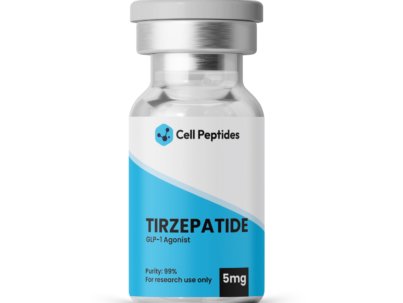- Fast shipping in Europe & USA
- Made in ISO 9001:2015 certified lab
- info@cellpeptides.com
GLP-1 peptides are a category of research compounds studied for their effects on blood sugar regulation, appetite suppression, and metabolic balance. These peptides mimic or enhance the action of glucagon-like peptide-1, a hormone that plays a central role in glucose homeostasis and energy intake. In laboratory settings, GLP-1 peptides are commonly investigated for their potential in obesity, type 2 diabetes, and weight management models.
GLP-1 peptides are a class of research compounds that mimic or enhance the activity of glucagon-like peptide-1, a hormone involved in appetite control, insulin secretion, and glucose metabolism. In scientific studies, these peptides are explored for their ability to suppress hunger, promote fat loss, and regulate blood sugar levels, making them a major focus in research targeting obesity, type 2 diabetes, and other metabolic disorders.
GLP-1 receptor agonists work by activating incretin pathways (GLP-1, GIP, and glucagon receptors), which collectively help improve insulin sensitivity, slow gastric emptying, reduce food intake, and increase metabolic expenditure. More advanced compounds in this class also target multiple receptors to enhance metabolic effects, offering new possibilities for studying complex weight-related mechanisms in lab settings.
Disclaimer: All GLP-1 peptides referenced here are intended for laboratory research use only. Any human-related outcomes mentioned are based solely on findings from animal models or clinical data and are not to be interpreted as medical advice or therapeutic recommendations.
GLP-1 receptor agonist peptides are synthetic compounds designed to replicate or enhance the effects of glucagon-like peptide-1 (GLP-1), an incretin hormone released by the gut after eating. In research settings, GLP-1 is known for its ability to stimulate insulin secretion, suppress appetite, slow gastric emptying, and regulate blood sugar. However, the natural hormone breaks down quickly in the body, prompting the development of longer-lasting analogs for laboratory use.
Modern GLP-1 peptides are engineered for increased stability and often include multi-receptor activity. In addition to GLP-1 activation, some of these peptides also target:
These combined effects make GLP-1 receptor agonists valuable in preclinical research models focused on:
Peptides such as Semaglutide, Tirzepatide, and Retatrutide are commonly used in this research category for their powerful metabolic and weight-reducing effects.
GLP-1 receptor agonist peptides work by mimicking or enhancing natural gut hormones that regulate hunger, insulin release, and energy metabolism. Each peptide in this category acts on different combinations of receptors to drive metabolic effects. Here’s a breakdown of the mechanisms by individual peptide:
Semaglutide
Tirzepatide
Retatrutide
Together, these peptides represent a powerful class of metabolic regulators in laboratory studies, offering insight into appetite control, insulin dynamics, and energy balance.
GLP-1 peptides like Semaglutide, Tirzepatide, and Retatrutide have reshaped metabolic research due to their powerful effects on weight loss, appetite regulation, and glucose control. Each has been studied in extensive clinical and laboratory trials, with consistently strong outcomes:
Overall Insights
All three peptides consistently show:
These findings have solidified GLP-1 receptor agonists as cornerstone compounds in obesity and metabolic research.
GLP-1 peptide research continues to evolve, with several compounds already approved for clinical use and others in advanced trial phases:
Semaglutide is FDA-approved for both type 2 diabetes (as Ozempic) and chronic weight management (as Wegovy). It is widely studied in metabolic models and has a well-documented safety profile in both diabetic and non-diabetic populations.
Tirzepatide, a dual GLP-1/GIP agonist, is also FDA-approved for type 2 diabetes (as Mounjaro) and is under review for obesity-related approvals, following positive SURMOUNT trial data.
Retatrutide, the triple agonist (GLP-1, GIP, glucagon), remains investigational but has shown groundbreaking results in Phase II trials, with potential to become a new class leader in fat loss and metabolic support research.
Commonly observed effects in research include:
Usage Guidelines:
Important Reminder:
All peptides discussed are intended strictly for laboratory research use only. They are not approved for human administration unless under regulated clinical trial or prescription contexts.
GLP-1 peptides have revolutionized metabolic and obesity-related research. The following peptides stand out for their well-documented efficacy in preclinical and clinical models:
GLP-1 peptides like Semaglutide, Tirzepatide, and Retatrutide must be properly reconstituted and handled under sterile lab conditions to maintain stability and accuracy in research.
Reconstitution: Most GLP-1 peptides can be reconstituted using bacteriostatic water or sterile saline. Slowly inject the solvent down the inner wall of the vial to avoid foaming, and gently swirl until fully dissolved.
Storage:
Dosing in Preclinical Models:
Standard dosing ranges from 0.01–0.2 mg/kg in mice or rats, depending on the experimental setup and research goals.
These peptides are intended solely for laboratory research, and all handling should follow ethical protocols and sterile best practices.
Retatrutide has demonstrated the most significant weight loss (~24%) in early clinical trials.
Not usually. Retatrutide already activates GLP-1, GIP, and glucagon receptors, making additional stacking unnecessary.
Gently swirl the vial, do not shake. Slight warming (in a 37°C water bath) can assist dissolution.
Yes. Semaglutide selectively targets GLP-1 receptors, while Tirzepatide and Retatrutide act on multiple receptors for a broader effect.
To finish up, GLP-1 peptides represent a leading edge in metabolic research, offering compelling avenues to study fat loss, insulin regulation, and appetite suppression. Peptides such as Semaglutide, Tirzepatide, and Retatrutide have shown significant effects in both preclinical and clinical models, making them valuable tools for obesity and diabetes-related investigations.
Explore the full GLP-1 peptide catalog at CellPeptides to support your next metabolic research project.
GLP-1 Peptides
GLP-1 peptides are a category of research compounds studied for their effects on blood sugar regulation, appetite suppression, and metabolic balance. These peptides mimic or enhance the action of glucagon-like peptide-1, a hormone that plays a central role in glucose homeostasis and energy intake. In laboratory settings, GLP-1 peptides are commonly investigated for their potential in obesity, type 2 diabetes, and weight management models.
GLP-1 peptides are a class of research compounds that mimic or enhance the activity of glucagon-like peptide-1, a hormone involved in appetite control, insulin secretion, and glucose metabolism. In scientific studies, these peptides are explored for their ability to suppress hunger, promote fat loss, and regulate blood sugar levels, making them a major focus in research targeting obesity, type 2 diabetes, and other metabolic disorders.
GLP-1 receptor agonists work by activating incretin pathways (GLP-1, GIP, and glucagon receptors), which collectively help improve insulin sensitivity, slow gastric emptying, reduce food intake, and increase metabolic expenditure. More advanced compounds in this class also target multiple receptors to enhance metabolic effects, offering new possibilities for studying complex weight-related mechanisms in lab settings.
Disclaimer: All GLP-1 peptides referenced here are intended for laboratory research use only. Any human-related outcomes mentioned are based solely on findings from animal models or clinical data and are not to be interpreted as medical advice or therapeutic recommendations.
GLP-1 receptor agonist peptides are synthetic compounds designed to replicate or enhance the effects of glucagon-like peptide-1 (GLP-1), an incretin hormone released by the gut after eating. In research settings, GLP-1 is known for its ability to stimulate insulin secretion, suppress appetite, slow gastric emptying, and regulate blood sugar. However, the natural hormone breaks down quickly in the body, prompting the development of longer-lasting analogs for laboratory use.
Modern GLP-1 peptides are engineered for increased stability and often include multi-receptor activity. In addition to GLP-1 activation, some of these peptides also target:
These combined effects make GLP-1 receptor agonists valuable in preclinical research models focused on:
Peptides such as Semaglutide, Tirzepatide, and Retatrutide are commonly used in this research category for their powerful metabolic and weight-reducing effects.
GLP-1 receptor agonist peptides work by mimicking or enhancing natural gut hormones that regulate hunger, insulin release, and energy metabolism. Each peptide in this category acts on different combinations of receptors to drive metabolic effects. Here’s a breakdown of the mechanisms by individual peptide:
Semaglutide
Tirzepatide
Retatrutide
Together, these peptides represent a powerful class of metabolic regulators in laboratory studies, offering insight into appetite control, insulin dynamics, and energy balance.
GLP-1 peptides like Semaglutide, Tirzepatide, and Retatrutide have reshaped metabolic research due to their powerful effects on weight loss, appetite regulation, and glucose control. Each has been studied in extensive clinical and laboratory trials, with consistently strong outcomes:
Overall Insights
All three peptides consistently show:
These findings have solidified GLP-1 receptor agonists as cornerstone compounds in obesity and metabolic research.
GLP-1 peptide research continues to evolve, with several compounds already approved for clinical use and others in advanced trial phases:
Semaglutide is FDA-approved for both type 2 diabetes (as Ozempic) and chronic weight management (as Wegovy). It is widely studied in metabolic models and has a well-documented safety profile in both diabetic and non-diabetic populations.
Tirzepatide, a dual GLP-1/GIP agonist, is also FDA-approved for type 2 diabetes (as Mounjaro) and is under review for obesity-related approvals, following positive SURMOUNT trial data.
Retatrutide, the triple agonist (GLP-1, GIP, glucagon), remains investigational but has shown groundbreaking results in Phase II trials, with potential to become a new class leader in fat loss and metabolic support research.
Commonly observed effects in research include:
Usage Guidelines:
Important Reminder:
All peptides discussed are intended strictly for laboratory research use only. They are not approved for human administration unless under regulated clinical trial or prescription contexts.
GLP-1 peptides have revolutionized metabolic and obesity-related research. The following peptides stand out for their well-documented efficacy in preclinical and clinical models:
GLP-1 peptides like Semaglutide, Tirzepatide, and Retatrutide must be properly reconstituted and handled under sterile lab conditions to maintain stability and accuracy in research.
Reconstitution: Most GLP-1 peptides can be reconstituted using bacteriostatic water or sterile saline. Slowly inject the solvent down the inner wall of the vial to avoid foaming, and gently swirl until fully dissolved.
Storage:
Dosing in Preclinical Models:
Standard dosing ranges from 0.01–0.2 mg/kg in mice or rats, depending on the experimental setup and research goals.
These peptides are intended solely for laboratory research, and all handling should follow ethical protocols and sterile best practices.
Retatrutide has demonstrated the most significant weight loss (~24%) in early clinical trials.
Not usually. Retatrutide already activates GLP-1, GIP, and glucagon receptors, making additional stacking unnecessary.
Gently swirl the vial, do not shake. Slight warming (in a 37°C water bath) can assist dissolution.
Yes. Semaglutide selectively targets GLP-1 receptors, while Tirzepatide and Retatrutide act on multiple receptors for a broader effect.
To finish up, GLP-1 peptides represent a leading edge in metabolic research, offering compelling avenues to study fat loss, insulin regulation, and appetite suppression. Peptides such as Semaglutide, Tirzepatide, and Retatrutide have shown significant effects in both preclinical and clinical models, making them valuable tools for obesity and diabetes-related investigations.
Explore the full GLP-1 peptide catalog at CellPeptides to support your next metabolic research project.





